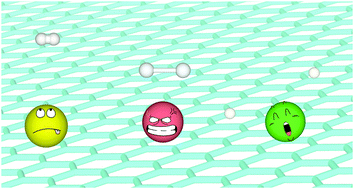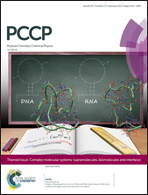On the H2 interactions with transition metal adatoms supported on graphene: a systematic density functional study†
Abstract
The attachment of H2 to the full set of transition metal (TM) adatoms supported on graphene is studied by using density functional theory. Methodology validation calculations on the interactions of H2 with benzene and graphene show that any of the vdW corrections under study, the Grimme D2, D3, D3 with Becke-Jonson damping (D3BJ), and Tkatchenko–Scheffler methods, applied on the PBE functional, are similarly accurate in describing such subtle interactions, with an accuracy of almost 2 kJ mol−1 compared to experiments. The PBE-D3 results show that H2 physisorbs on especially stable d5 or d10 TMs. In other 5d metals, and the rightmost 3d and 4d ones, H2 dissociates, and only for Y, Mn, Fe, and Zr the H2 binds strongly enough for its storage in the so-called Kubas mode, where the H2 bond is sensibly elongated. Other metals (Co, Ni, Ru, Rh and Pd) feature also an elongated Kubas mode, interesting as well for H2 storage. Sc and Ti display a Kubas modes especially suited, given their lightness, for meeting the gravimetric requirements. The H2 interactions with TM adatoms imply a TM → H2 charge transfer, although the magnetic moment of the system tends to remain intact, except for the early 5d TMs, where the unpaired electron transfer seems to be associated with the H2 bond breakage.



 Please wait while we load your content...
Please wait while we load your content...